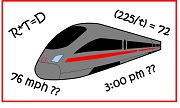While patients are consumers of healthcare services, they can’t be considered customers in the traditional sense. The same is true of students. Over many years of teaching, I’ve noticed this parallel between the healthcare and education professions; both require significantly more “customer participation” to achieve desired outcomes than other industries do. That’s one reason it’s difficult to measure the quality of these institutions and the skills of their practitioners. That’s also why both industries focus so intently on engaging our communities; we simply can’t be successful unless we do.
“Can You Hear Me Now?”
As the old joke goes, there are 3 types of people in this world: those who are good at math and those who aren’t. Many students believe themselves to be permanent denizens of the 2nd camp. They find mathematical concepts confusing and the terminology inscrutable, so they tend not to ask questions. They’re afraid they’re being judged, so they’re not always truthful. Tests and exams fill them with anxiety, and sometimes even panic (no doubt waking to nightmares of trains leaving stations at varying rates of speed). These are the students who need my help the most. Our success in overcoming these challenges together will depend heavily on the student/teacher connection we can establish, yet few students are actually able to choose the teacher with whom they are asked to connect. Sound like healthcare yet?
